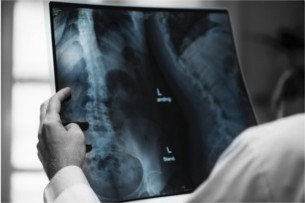Medical Negligence During Delivery leads to Wrongful Death of Mother
Medical Malpractice and Wrongful Death Case: History
Lyndsay Biggar was eight-plus months pregnant in 2019, and working at her job as a law enforcement officer, when she felt a gush of fluid. Convinced her water had broken, Lyndsay called her obstetrician’s office. She was instructed to go to the labor and delivery unit at ABC Hospital for evaluation and likely delivery.
As Lyndsay drove herself to the hospital, she called her husband, Ron, to let him know the baby was on its way. Ron rushed to the hospital, beating Lyndsay there by a few minutes. Lyndsay was admitted to the labor and delivery unit. She was seen there by several different doctors, most of whom were still in training.
The doctors and nurses spent nearly three hours trying to confirm that Lyndsay’s water indeed had broken. Meanwhile, her labor was progressing – rapidly. Lyndsay had a history of rapid labor, having given birth previously to a son just two hours after her water had broken.
To complicate matters further, this baby was in the breech position, meaning its bottom was closest to the birth canal instead of its head. In addition, Lyndsay had suffered a small hemorrhage following the birth of her son. For these reasons and others, the plan was to deliver this baby by Cesarean section.
Unfortunately, no one told the baby, who had other ideas. As hospital personnel spent time trying to confirm Lyndsay’s water had broken, the baby kept moving– butt first – further down the birth canal. The further down the birth canal a breech baby travels, the more difficult a C-section becomes. Still, according to the operative reports, the delivery went according to plan. The baby was delivered healthy, and everything looked good.
Until it didn’t. Minutes after the baby was delivered, while the doctors were still finishing the procedure, the color drained from Lyndsay’s face, and she began to bleed profusely. A large tear was noted on the lower half of Lyndsay’s uterus. The obstetrician called a gynecologic surgeon for help. By the time the gyn-surgeon arrived several minutes later, it was clear that Lyndsay’s uterus would have to be removed.
Ron was ushered from the room as Lyndsay was given general anesthesia. Although the gyn-surgeon successfully removed Lyndsay’s uterus, she could not stop the bleeding. Ultimately, the gyn-surgeon called in a trauma surgeon, who eventually located multiple bleeding sites and managed to control the bleeding. However, Lyndsay lost more than 40 liters of blood during the ordeal. (Her circulating blood volume was likely around 5 liters, so her entire blood volume was replaced eight times.) In addition, Lyndsay’s heart stopped, a Code Blue was called, and she was resuscitated. She was then transferred to ICU in critical condition, sedated, intubated, and on a ventilator.
The massive bleeding took its toll. Lyndsay suffered an anoxic brain injury. In other words, she lost so much blood that her brain did not get enough oxygen, resulting in significant and permanent brain injury. The next day, Lyndsay began experiencing seizures, an additional sign of brain injury. Imaging studies confirmed the near-global extent of the brain damage.
A neurologist determined that Lyndsay had minimal or no chance of meaningful neurologic recovery. She was admitted to hospice and a little more than two hours later, she was extubated and died.
Medical Negligence and Wrongful Death Case: Litigation
Ron Biggar hired The Eisen Law Firm to represent him in the investigation of potential medical negligence and wrongful death claims. The investigation began immediately thereafter.
Lead Counsel, Brian N. Eisen, began by collecting all of the key medical records, including records from Lyndsay’s two deliveries at ABC Hospital, records from another hospital that provided some of Lyndsay’ prenatal care, and records from Lyndsay’s OB/Gyn. He also obtained records from Lyndsay’s primary care doctor and her chiropractor. Collecting the records was difficult, as several providers initially either refused or failed to provide complete records. Ultimately, however, the records were secured. Computer disks containing several ultrasound studies were also obtained.
The Eisen Law Firm does not utilize nurse paralegals. Instead, Mr. Eisen reviews all medical records – page by page – himself. Mr. Eisen reviewed more than 2,400 pages of records in this case during the course of the initial investigation. As it turned out, obtaining records from Lyndsay’s prior labor and delivery was critical to the analysis of the case, as those records contained information suggesting that Lyndsay was at increased risk for a rapid labor and for post-partum hemorrhage in this, her last delivery.
Mr. Eisen also used public records requests to obtain documents from the Ohio State Medical Board, including the applications for licensure of the various physicians involved in Lyndsay’s care. These records often provide invaluable background information on the key players and can be the source of helpful impeachment material.
Just as Mr. Eisen does not rely on paralegals or third-party services to review and analyze medical records, he performs his own exhaustive medical research. In this case, Mr. Eisen personally researched, retrieved, reviewed, and analyzed the following primary journal articles in connection with his preparation of this case:
Author
Title
Journal
Year
| |
Berg
Preventability of Pregnancy-Related Deaths
Obstet Gynecol
2005
| |
Ohio Department of Health
A Report on Pregnancy-Associated Deaths in Ohio 2008-2016
Self Published
2019
| |
Herbert
Postpartum Hemorrhage
ACOG Practice Bulletin
2006
| |
Kutcher
Acute coagulopathy associated with trauma (ACoTS)
UpToDate
2019
| |
Kushimoto
Acute traumatic coagulopathy and trauma-induced coagulopathy: an overview
Journal of Intensive Care
2017
| |
Cromi
Blunt expansion of the low transverse uterine incision at cesarean delivery: a randomized comparison of 2 techniques
Am J Obstet Gynecol
2008
| |
Rodriguez
Blunt versus sharp expansion of the uterine incision in low-segment transverse cesarean section
Am J Obstet Gynecol
1994
| |
Burtelow
How we treat: management of life-threatening primary postpartum hemorrhage with a standardized massive transfusion protocol
TRANSFUSION
2007
| |
Selo-Ojeme
Caesarean delivery at full cervical dilatation versus caesarean delivery in the Wrst stage of labour: comparison of maternal and perinatal morbidity
Arch Gynecol Obstet
2008
| |
CDC
Pregnancy-Related Deaths Happen Before, During, and Up to a Year After Delivery
CDC Newsroom
2019
| |
Xodo
Cephalad-caudad versus transverse blunt expansion of the low transverse uterine incision during cesarean delivery
European Journal of Obstetrics and Gynecology and Reproductive Biology
2016
| |
Berghella
Cesarean delivery: Surgical technique
UpToDate
2019
| |
Duhan
Circumferential Avulsion of the Uterine Body from the Lower Segment During Cesarean Section: Complication of a Wedged Fetal Head
JOURNAL OF GYNECOLOGIC SURGERY
2012
| |
Manning
Delivery of an Impacted Fetal Head During Cesarean: A Literature Review and Proposed Management Algorithm
OBSTETRICAL AND GYNECOLOGICAL SURVEY
2015
| |
Hofmeyr
Delivery of the singleton fetus in breech presentation
UpToDate
2019
| |
Zhou
The Effect of Maternal Death on the Health of the Husband and Children in a Rural Area of China: A Prospective Cohort Study
PLOS ONE
2016
| |
Porreco
The changing specter of uterine rupture
Am J Obstet Gynecol
2009
| |
Omole-Ohonsi
Emergency Peripartum Hysterectomy
Book Chapter
| |
Magann
Intra‐operative haemorrhage by blunt versus sharp expansion of the uterine incision at caesarean delivery: a randomised clinical trial
BJOG: an International Journal of Obstetrics and Gynaecology
2002
| |
The Joint Commission
Provision of Care, Treatment, and Services standards for maternal safety
Self Published
2019
| |
Rushdan
Lower Segment Caesarean Section: Evidence-Based Practice
Journal of Surgical Academia
2015
| |
Clark
Maternal death in the 21st century: causes, prevention, and relationship to cesarean delivery
Am J Obstet Gynecol
2008
| |
Haeri
Maternal Mortality From Hemorrhage
Sein Perinatol
2011
| |
Wetzel
Maternal mortality statistics
Contemporary OBGYN
2018
| |
Petersen
Vital Signs: Pregnancy-Related Deaths, United States, 2011–2015, and Strategies for Prevention, 13 States, 2013–2017
CDC
2019
| |
Ghodki
Obstetric hemorrhage: anesthetic implications and management
ANAESTH, PAIN & INTENSIVE CARE
2014
| |
Hanretty
Obstetrics Illustrated
Obstetrical Operations and Meternal Injuries
2010
| |
Ohio Department of Health
Ohio Pregnancy-Associated Mortality Review (A Focus on Pregnancy-Related Deaths)
Self Published
2018
| |
Antony
Postpartum hemorrhage: The role of the Maternal–Fetal Medicine specialist in enhancing quality and patient safety
Semin Perinatol
2013
| |
James
Postpartum hemorrhage: When uterotonics and sutures fail
American Journal of Hematology
2012
| |
Lockwood
Preventing maternal mortality
Contemporary OBGYN
2019
| |
Anderson
Prevention and Management of Postpartum Hemorrhage
American Family Physician
2007
| |
Kumari
Reducing morbidity in second stage cesarean section by Patwardhan’s (shoulders first) method of delivery
Int J Reprod Contracept Obstet Gynecol
2018
| |
Various
Report from Nine Maternal Mortality Reivew Committees
Review to Action
2019
| |
Unterscheider
Rising rates of caesarean deliveries at full cervical dilatation: a concerning trend
European Journal of Obstetrics & Gynecology and Reproductive Biology
2011
| |
Gallos
The Role of the Anesthesiologist in Management of Obstetric Hemorrhage
Semin Perinatol
2008
| |
Conrey
Severe Maternal Morbidity, A Tale of 2 States Using Data for Action—Ohio and Massachusetts
Matern Child Health J
2019
| |
Warwick
The bottom line: Iatrogenic fetal anal trauma in undiagnosed breech presentation
British Journal of Midwifery
2013
| |
University Hospitials of Cleveland
Infant & Maternal Mortality: Improving Outcomes for Mothers and Infants
Innovations in Obstetrics & Gynecology
2019
| |
Giugale
Unintended hysterotomy extension during caesarean delivery: risk factors and maternal morbidity
Journal of Obstetrics and Gynaecology
2018
| |
Sheldon
Postpartum haemorrhage management, risks, and maternal outcomes: findings from the World Health Organization Multicountry Survey on Maternal and Newborn Health
BJOG: an International Journal of Obstetrics and Gynaecology
2013
| |
Barbieri
Does your obstetric unit have a protocol for treating amniotic fluid embolism?
OBG Management
2014
| |
Committee on Obstetric Practice
Amnioinfusion Does Not Prevent Meconium Aspiration Syndrome
ACOG Committee Opinion
2006
| |
Matsuo
Anaphylactoid syndrome of pregnancy immediately after intrauterine pressure catheter placement
Am J Obstet Gynecol
2008
| |
Clark
Amniotic fluid embolism: Analysis of the national registry
Am J Obstet Gynecol
1995
| |
Matsuo
Anaphylactoid syndrome of pregnancy immediately after intrauterine pressure catheter placement
Am J Obstet Gynecol
2008
| |
Hofmeyr
Amnioinfusion for meconium-stained liquor in labour (Review)
The Cochrane Collaboration
2014
| |
Hofmeyr
Amnioinfusion: a question of benefits and risks
J Obstet Gynecol
1996
| |
Tuffnell
Amniotic fluid embolism an update
The Association of Anaesthetists of Great Britain and Ireland
2010
| |
Perozzi
Amniotic Fluid Embolism An Obstetric Emergency
CriticalCareNurse
2004
| |
Conde-Agudelo
AMNIOTIC FLUID EMBOLISM: AN EVIDENCEBASED REVIEW
Am J Obstet Gynecol
2009
| |
Gist
Amniotic Fluid Embolism
Anesth Analg
2009
| |
Levi
Disseminated intravascular coagulation.
Crit Care Med
2007
| |
Lofsky
Doctors Company Reviews Maternal Arrests Cases
APSF NEWSLETTER
2007
| |
Dorairajan
Maternal death after intrapartum saline amnioinfusion—report of two cases
BJOG: an International Journal of Obstetrics and Gynaecology
2005
| |
Fraser
Amnioinfusion for the Prevention of the Meconium Aspiration Syndrome
n engl j med
2005
| |
Conde-Agudelo
ARDS, adult respiratory distress syndrome
Am J Obstet Gynecol
2009
| |
Harbison
Anaphylactoid Syndrome After Intrauterine Pressure Catheter Placement
Obstet Gynecol
2010
| |
WALLACE
Extraovular placement of intrauterine pressure catheters in laboring patients
4TH WORLD CONGRESS OF PERINA T AL MEDICINE
1999
| |
Nagarsheth
Successful Placement of a Right Ventricular Assist Device for Treatment of a Presumed Amniotic Fluid Embolism
Anesth Analg
2008
| |
Babaknia
POSTPARTUM HEMORRHAGE
Patient Safety Movement Foundation
2017
| |
SHIELDS
BLOOD PRODUCT REPLACEMENT: OBSTETRIC HEMORRHAGE
CMQCC OBSTETRIC HEMORRHAGE TOOLKIT
2009
| |
Chatrath
Fluid management in patients with trauma: Restrictive versus liberal approach
J Anaesthesiol Clin Pharmacol
2015
| |
Hess
Massive blood transfusion
UpToDate
2019
| |
Cryer
ACS TQIP Massive Transfusion in Trauma Guidelines
Am. College of Surgeons?
| |
Goffman
Maternal Safety Bundles for Obstetric Hemorrhage
Am. Cong. of Obstet Gynecol
2014
| |
Main
Consensus Bundle on Obstetric Hemorrhage
Obstet Gynecol
2015
| |
Puget Sound Blood Center
Obstetrical (OB) Hemorrhage Guidelines
Self Published
| |
Council on Patient Saftey in Women’s Health Care
Obstetric Hemorrhage
Am. Cong. of Obstet Gynecol
2015
| |
Butwick
Transfusion and coagulation management in major obstetric hemorrhage
Curr Opin Anaesthesiol
2015
| |
Pacheco
An Update on the use of Massive Transfusion Protocols in Obstetrics
Am J Obstet Gynecol
2015
| |
Committee on Obstetric Practice
Genetic Syndromes and Gynecologic Implications in Adolescents
ACOG Committee Opinion
2019
| |
Prahlow
Death Due to Ehlers-Danlos Syndrome Type IV
Am J Forensic Med Pathol
2005
| |
Sobey
Ehlers–Danlos syndrome: how to diagnose and when to perform genetic tests
Arch Dis Child
2015
| |
Lurie
The threat of type IV Ehlers-Danlos syndrome on maternal well-being during pregnancy: early delivery may make the difference
Journal of Obstetrics and Gynaecology
1998
| |
Ernest
EDS and Pregnancy 2013
Ehlers-Danlos National Foundation
2013
| |
Lind
Pregnancy and the Ehlers–Danlos syndrome: a retrospective study in a Dutch population
Acta Obstet Gynecol Scand
2002
| |
Fraser
Neurological and spinal manifestations of the Ehlers-Danlos syndromes
AMERICAN JOURNAL OF MEDICAL GENETICS PART C
2017
| |
Dutta
Pregnancy and Delivery in Ehlers-Danlos Syndrome (Hypermobility Type): Review of the Literature
Obstetrics and Gynecology International
2011

Once Mr. Eisen developed a complete understanding of Lyndsay’s medical history, the events of her two deliveries, and the medical issues involved, he set about putting together a team of experts to review and prosecute the case.
Four defense-oriented, board-certified specialists in maternal fetal medicine were contacted by Mr. Eisen. Two declined to get involved but agreed not to take on the case for the defense. Two reviewed the case. Mr. Eisen pushed them to develop ideas about where the defense might go. Among the most concerning things they mentioned was the possibility Lyndsay might have had a genetic condition called Ehlers-Danlos Syndrome. People with EDS often have very friable tissue. In a pregnant woman, this can cause an unavoidable tear in the uterus, which can cause fatal postpartum bleeding.
Mr. Eisen wanted either to confirm or disprove fully the hypothesis that Lyndsay’s death was related to an undiagnosed genetic condition. He therefore retained an expert in EDS (identified while reviewing the articles listed above) to discuss the matter in depth. Mr. Eisen then located a genetic laboratory on the west coast to perform the necessary DNA tests and engaged a physician to order those tests. Fortunately, the tests demonstrated that Lyndsay did not have EDS, which closed off that potentially devastating avenue of defense.
In addition to the two defense-oriented maternal fetal medicine specialists and the EDS expert and laboratory, Mr. Eisen consulted with and/or retained three other MFM specialists, one OB/GYN, a labor and delivery nurse, and an anesthesiologist. Some of these experts were familiar to Mr. Eisen from other cases and were willing to consult with him on this matter at a reduced rate, to the ultimate benefit of the case. Once the team was assembled, Mr. Eisen obtained affidavits of merit from a maternal fetal medicine specialist and from a specialist in anesthesiology. The MFM specialist was critical of the care given by the labor and delivery nurses and by the obstetricians who performed Lyndsay’s C-section. The anesthesiologist was critical of the efforts made to resuscitate Lyndsay once she began hemorrhaging after the delivery.
Medical Error and Wrongful Death Case: Negotiations and Proposed Settlement
Once the case was prepared fully, Mr. Eisen approached ABC Hospital to discuss a potential resolution of the matter. Mr. Eisen has handled medical negligence cases exclusively for the past 25 years, and he has had many cases – both settlements and jury trials – involving ABC Hospital. He has developed over the years an excellent reputation, with the defense bar in general and ABC Hospital specifically, as a zealous and knowledgeable advocate and adversary. As such, he has been able to reach early, significant resolutions with ABC Hospital from time to time.
Mr. Eisen slowly and deliberately built up over time and shared with ABC Hospital the “damages” aspect of the case. He began by obtaining Lyndsay’s employment records and tax returns and hiring an economist to determine the economic impact of Lyndsay’s death. Then, he invested nearly two months putting together (along with a film production company) a documentary-type film featuring Lyndsay’s family and friends discussing the events surrounding her pregnancy, her labor and delivery, her death, and its aftermath. The film included seven live interviews, video footage of Lyndsay obtained by Mr. Eisen from Lyndsay’s employer, photographs, voicemail recordings, and music. This film played a significant role in moving forward the settlement discussions.
As the one-year statute of limitations for the underlying medical negligence claim approached, Mr. Eisen agreed to hold off on filing suit and entered into a tolling agreement with ABC Hospital, in order to give a bit more time for the parties to reach a negotiated resolution. Eventually, the parties agreed to a confidential seven-figure settlement.
The Eisen Law Firm: Medical Malpractice Exclusively
When Ron Biggar hired The Eisen Law Firm, he knew that he was getting a firm that handles medical malpractice cases exclusively. Mr. Biggar wanted to select the best lawyer for the job, one who does not handle hundreds of cases but rather only a few cases, each of which gets a lot of attention. He wanted to be able to talk directly and as often as he liked to the attorney doing the work, and he wanted to hire someone who understood both the medical and the legal aspects of his case. He got all of that and more when he hired The Eisen Law Firm.
In addition to our proven results, The Eisen Law Firm does not hesitate to spend whatever is necessary in these cases. (Incidentally, many firms borrow the funds needed to finance their cases and then charge interest to the clients. The Eisen Law Firm does not engage in this practice.) The Eisen Law Firm also was prepared to commit whatever time was necessary to see this matter through to completion, whether that time was measured in days, months, years, or even (as occurs very, very rarely) decades. In order to commit the time and money necessary to handle these kinds of cases, The Eisen Law Firm limits its representation to only a few cases per year. The Eisen Law Firm regularly turns down new clients with potentially strong cases to maintain its focus on existing clients, as it did for Mr. Biggar and his family.
Mr. Biggar and Mr. Eisen remain in touch and likely will stay in touch as Mr. Biggar and his family move forward with their lives.




